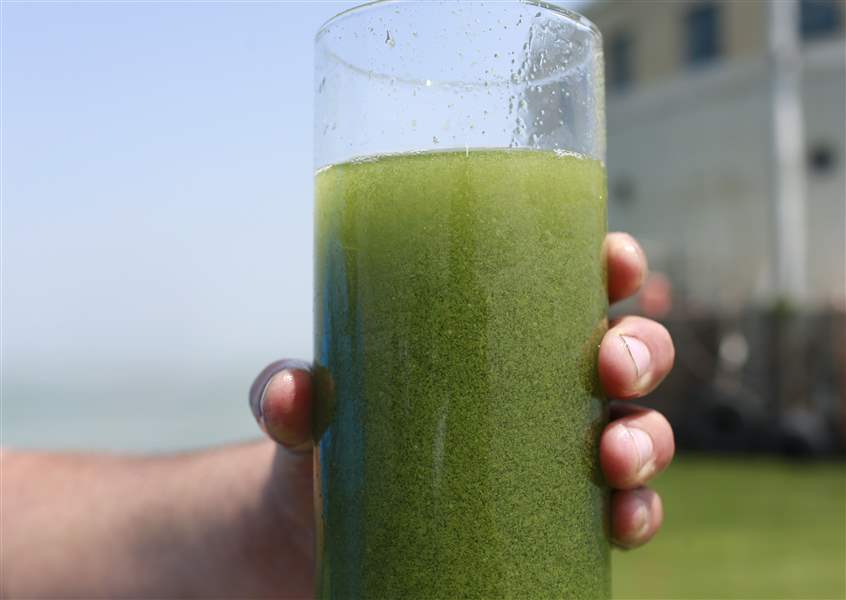
Toledo, Oregon push for stronger Lake Erie protections
8/12/2018
In this Aug. 3, 2014 photo, a sample glass of Lake Erie water is photographed near the City of Toledo water intake crib, in Lake Erie, about 2.5 miles off the shore of Curtice, Ohio.
ASSOCIATED PRESS
Toledo and Oregon have become parties to a lawsuit filed by two groups that calls upon U.S. District Judge James G. Carr to order the most comprehensive cleanup strategy for western Lake Erie, known as a total maximum daily load.
The next court date is Aug. 21.
The U.S. Department of Justice, on behalf of the U.S. Environmental Protection Agency, is opposed.
The two plaintiffs, the Midwestern-based Environmental Law & Policy Center and the Toledo-based Advocates for a Clean Lake Erie, contend the federal Clean Water Act requires the highly aggressive TMDL cleanup strategy to be followed by the Ohio Environmental Protection Agency once the Kasich administration finally relented in March — after years of resistance — and declared western Lake Erie’s open waters to be impaired.
They want the judge to impose a TMDL order on the U.S. EPA, with the understanding the federal agency would then require the Ohio EPA to carry out the program.
Toledo’s decision to get involved dates back to May 1, 2017, a day before Mayor Wade Kapszukiewicz announced his candidacy for that office.
During an all-day tour of southeast Michigan factory farms, Mr. Kapszukiewicz, a Democrat, told The Blade there were two things he would do if elected: First, call for the impairment status and, second, have Toledo assist the two plaintiffs in their lawsuit.
He never had to call for the impairment status once elected because former Mayor Paula Hicks-Hudson — a Democrat who had long sided with the Kasich administration on that issue — had a sudden change of heart last September, weeks before the election, after a thick blanket of algae appeared in downtown Toledo just as ProMedica was preparing for a major regatta near Promenade Park.
“I campaigned on cleaning up the lake and we are following through on that today by filing this motion,” Mr. Kapszukiewicz said in his prepared remarks Friday, referring to a court filing known as an amicus brief.
“We need to hold the nonpoint sources accountable and this is one way we can do it. We support the efforts of the Environmental Law & Policy Center, Advocates for a Clean Lake Erie, and Mike Ferner, who has pushed for years to get tougher regulations for polluters,” the statement said.
The city of Oregon co-signed the eight-page memorandum. That city’s mayor, Michael J. Seferian, said in his prepared remarks that it is “important for our communities to continue to work together to protect the lake.”
In the motion, the two cities argue they should be given standing as plaintiff parties because they believe the U.S. EPA “is refusing to protect the environment by continuing to allow the state of Ohio to ignore the mandates of the Clean Water Act.”
“The Clean Water Act’s requirement to create a TMDL for an impaired waterway is a solution to [a] pollution problem that involves many actors,” lawyers for the two cities wrote.
Their brief cited The Blade’s coverage of an Ohio EPA report from April that contends 88 percent of algae-forming phosphorus flowing down the Maumee River and into Lake Erie comes from nonpoint sources like agricultural runoff.
“Voluntary measures of reducing nonpoint sources of nutrients are not working,” the memo states. “Without the guidance and accountability that a TMDL analysis would provide, it is highly doubtful that the political support will exist to hold nonpoint polluters accountable in a regulatory manner. Hence, the phosphorus loading will continue unabated and Lake Erie will continue to turn green every year.”
Howard Learner, ELPC’s executive director, welcomed support from the two cities, telling The Blade it is “an important action for advancing necessary solutions to reduce agricultural runoff pollution that is contaminating Lake Erie.”
Local residents are “entitled to safe, clean drinking water supplies and a healthy Lake Erie fishery and ecosystem,” he said.
Said Mr. Ferner: “It's an encouraging difference from past city administrations, which didn't even recognize Lake Erie was impaired. It should add momentum to the lawsuit and hopefully encourage Judge Carr to make the EPA do its job.”
The U.S. EPA declined to comment, citing its longstanding policy against talking about cases in progress.
The Ohio EPA and the Kasich administration did not respond to requests for comment.
The Justice Department, in open court and in briefs, has asked Judge Carr to dismiss the case on the grounds plaintiffs got what they wanted from an impairment designation. The plaintiffs have argued the judge should retain jurisdiction to ensure the designation is more than symbolic.
Justice Department lawyers also have stated, including in a document filed Monday, the Ohio EPA has never “clearly and unambiguously abandoned its obligation to produce a TMDL.” Plaintiffs point to at least one statement by an agency official claiming the Ohio EPA is not interested in going that route.
The Kasich administration, as an alternative, proposed designating several watersheds flowing into western Lake Erie as “distressed” to make them eligible for stronger Ohio Department of Agriculture oversight of manure application. That initiative, though, has been indefinitely put on hold by the Ohio Soil and Water Conservation Commission.
Contact Tom Henry at thenry@theblade.com, 419-724-6079, or via Twitter @ecowriterohio.